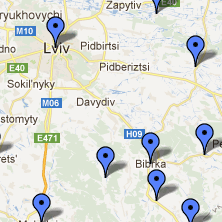A few months ago, dr Paul Glasser published a very useful set of maps with yiddish names of cities in Eastern Europe on his blog . These maps are very comprehensive and amazing but it’s still possible that your town won’t be listed on them. Perhaps the name of the town is not what you think, perhaps it has been adpated…
. These maps are very comprehensive and amazing but it’s still possible that your town won’t be listed on them. Perhaps the name of the town is not what you think, perhaps it has been adpated…
There are a few general rules how the Yiddish version for city names was usually coined. Raphael Mahler pointed them out while doing his research on Jewish demography in the 18th-century Polish-Lithuanian Commonwealth.
- city names ending –ów, –wo might turn to עוו, -ווע- (e.g. Tuchów -> טעכעוו);
- ending –iny, –ice, –yce might turn to יץ, -ין- (Gorlice -> גאָרליץ);
- city names might be translated,
- one of two adjacent consonants might be removed (Pokrzywnica -> פאָקשרוויצה or פאָקריוויצה);
- two adjacent consonants might be switched (Włostowice -> ואָלסטאָביץ);
- the first of two consonants at the beginning may be removed (Hrubieszów -> רובישיב)
- Slavic city names starting with ms-, msz– might have added a vowel at the beginning (Mszczonów -> אַמשינוב),
- sometimes rz, cz, dz, sz, ś might change to (respectively from right to left) ר, צ, ד, ש, ס.
Moreover, one city may have many different Yiddish names, even at the same time. For example, Piotrków Trybunalski had at least four Yiddish versions: פיאָטרקוב in the 2nd half of the 18th century and פיאָטריקוב or פיעטרקאָוו in the interwar period and, according to dr Glasser, its name was also פּעטריקעוו.
The Raphael Mahler’s list of Yiddish versions for 258 toponyms from the 18th-century Polish-Lithuanian Commonwealth can be found in:
רפאל מאהלר, שמות יהודים של מקומות בפולין הישנה, “רשומות” 5, 146-161.
and yes, it’s offline in a library.
